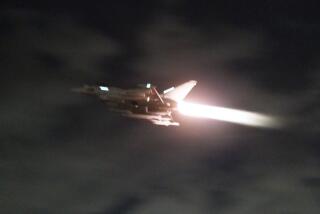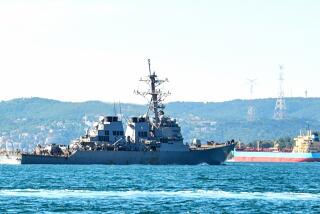Probe Urged in Missile Firing Near U.S. Warship
- Share via
ABOARD THE CHANDLER IN THE PERSIAN GULF — The captain of this U.S. Navy destroyer that narrowly avoided an Iraqi-fired missile said Saturday that he is urging the Pentagon to try to determine why the air-launched Silkworm made an unexpected turn that brought it within eight miles of a convoy of Kuwaiti tankers re-registered under the American flag.
“I don’t know whether the missile had some capability (to maneuver) that we didn’t know about or if it was defective,” Cmdr. Steve Smith, skipper of the Chandler, said. “As far as we know, the Silkworm flies in a straight line.”
The missile that flashed along the starboard side of the Chandler, another escorting warship and the four tankers would have passed well astern of the convoy if it had not made the unexpected turn. Another missile fired by the same Soviet-made Iraqi Badger medium-range bomber stayed well away from the convoy.
‘Unpredictable’ Weapons
“You don’t want a missile flying anywhere near you,” Smith said. “Missiles are unpredictable. You don’t want to be on the flight path of a missile.”
Smith called his ship to “general quarters”--the Navy’s highest state of alert--Friday night when radar showed that the Badger was immediately behind the convoy, flying a characteristic Iraqi ship-attack pattern that could have brought it right over the U.S. vessels.
Smith said he was particularly concerned that the Iraqi jet might fire its missiles from behind the convoy at potential targets in front of it. In such an attack, a missile falling short could smash into the U.S. ships. He said it was clear that the Iraqi did not intend to attack ships that were on their way to load oil and liquid gas in Kuwait, an Iraqi ally.
The Chandler warned the Iraqi pilot by radio. But Smith said the pilot did not seem to understand English--the international language of aviation--very well. One of the ship’s officers speaks Arabic, but no attempt was made to contact the pilot in his native language.
When the Badger did not change course after the radio warning, Smith said, the Chandler fired two flares from its five-inch gun. Less than a minute later, the Iraqi plane changed course, veering away from the convoy. Seconds after he made the turn, he fired both of his missiles. Radar on the Chandler showed no potential targets in the area where the missiles were aimed.
The incident occurred shortly after 9:00 p.m. local time, about the same time that Iraq now claims its pilots struck a “large maritime target,” the usual Iraqi term for a supertanker.
The missiles apparently were Chinese-made C-601 anti-ship weapons, the air-launched version of the Silkworm that Iran has installed in ground batteries along the Strait of Hormuz at the mouth of the Persian Gulf. It was erroneously reported earlier that the Iraqi fired Soviet-made Styx missiles, the weapon from which the Chinese copied the Silkworm.
Smith said the convoy was operating in the central gulf, less than 10 miles from the war zone along the Iranian coast. U.S. convoy operations try to stay well away from the zone, although at some points the gulf is too narrow to provide much margin for safety.
Capt. Bill Kelley, commodore of the squadron of one destroyer and six frigates that escort U.S.-registered ships in the gulf, was aboard the Chandler, his flagship, during the incident. He said he did not interfere with Smith’s handling of the incident.
“The last thing a commander needs is someone who is superior to him whispering in his ear when he is trying to fight his ship,” Kelley said.
However, Kelley said he suggested that the Reuben James, a frigate also in the convoy, go to general quarters at the same time the Chandler did.
“I think that the performance of both ships was outstanding,” he said. “I think that both ships were very close to pulling the trigger. Had they done so, it would have been correct but they were not incorrect for not having done so.”
Smith said he was within a minute or so of firing his Standard-1 anti-aircraft missile at the incoming Silkworm. He said that shoulder-fired Stinger rockets were ready on both ships and that the Phalanx close-in weapons system was set to fire automatically if the missile approached.
Smith said he seldom uses the dramatic “man your battle stations” order for general quarters. He said it is difficult to maintain that rate of readiness for more than eight hours because the crew becomes exhausted and there are no replacements available.
He said he usually maintains the ship at a state of readiness the Navy refers to as one-Alpha, in which all weapons are manned but fewer sailors are assigned to fire-fighting and damage-control duties. In that condition, personnel usually are on watch for six hours and off for six hours.
Although the Chandler and the Reuben James coordinated their responses to the incident, the four merchant ships--the supertankers Ocean City and Surf City and the liquid petroleum gas carriers Gas King and Gas Queen--were left to guess what was going on.
Shortly after the missile had passed the convoy, a radio operator on the Gas King asked the Chandler, “Should we be concerned about the flash of light that just went by on the starboard side?”
“Not anymore,” the Chandler replied laconically.
More to Read
Sign up for Essential California
The most important California stories and recommendations in your inbox every morning.
You may occasionally receive promotional content from the Los Angeles Times.













